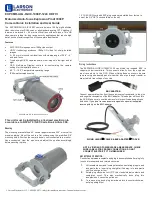
III - TROUBLESHOOTING
The Sx-70 camera is an electronically controlled
device, the electronics being in the integrated
circuits (IC) mounted in the Electronic Control
Modul (ECM) and Flash Fire Assembly (FFA)
in the shutter housing and in the Motor Control
Circuit (MCC) in the camera back. Because
the IC’s are non-reparaible items, there is no
requirement to trace faults whithin the integrated
circuits. It is mandatory, however, to be able to
identify the command inputs (switches open or
closed, etc.) and the resulting output signals.
The SX-70comprehensive Tester provides the
readouts necessary to confirm an exposure
malfunction; but thorough understanding of the
theory of operation is required if meaningful use
of the tester is expected. If a particular camera
function fails, it is necessary to recognize how
the failure is related to the operating sequence
of events and thus reduce testing procedures to
those related to the aera malfunction.
Because of the camera’s total automation, it
is unlikely that much useful guidance can be
obtained from customer complaints except
in cases of visible mechanical damage. For
this reason, a well defined series of checks,
observations, and tests must be followed. This
section of the manual defines these procedures.
The primary purpose of any fault analysis program
is to reduce the investigation time to a minimum.
Thus, it is not only important to establish a
fixed routine, but it is mandatory to acquire the
maximum amount of information from each step
of the checkout procedure. Use the charts at the
end of this section to guide through each step
of inspection, dynamic testing and post-repairs
tests.
Analysis of the SX-70 camera is a key part of
the complete repair task. If the analysis is done
correctly, it will eliminate excessive repair time
and high parts replacement cost. For instance,
initial evaluation may show the entire shutter
to be at fault; however, continuing analysis
determines that the problem is in solenoid #2,
which, when replaced reduces the materiel cost
considerably (from over 20 $ to under 2 $). The
repair person must always consider the labor vs.
material trade-off when making a repair.
Do not make any arbitrary assumptions. An
assembly or component should be thoroughly
tested to determine whether or not it is performing
its function correctly. Complete the tests in the
chart below.
A. INTRODUCTION
B. INITIAL TESTS
















































